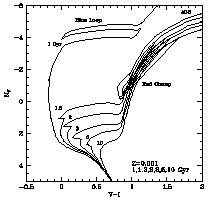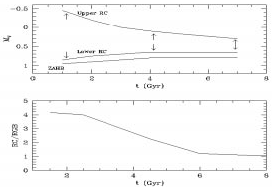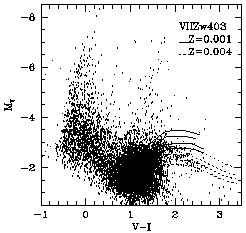


Much of our detailed knowledge of the SFHs of galaxies beyond 1 Gyr ago comes from the Milky Way and its nearby dSph satellites or from HST CMDs. To date, the limiting factors have been crowding and resolution limits for accurate stellar photometry from the ground. HST provides a unique opportunity to extend beyond our immediate vicinity and encompass the whole LG. To date HST has observed the resolved stellar populations in variety of nearby galaxies (e.g., dE, NGC 147, Han et al. 1997; Irr, LMC, Geha et al. 1998; Spiral, M 31, Holland et al. 1996; BCD, VII Zw 403, Lynds et al. 1998; dI, Leo A, Tolstoy et al. 1998; dSph, Leo I, Gallart et al. 1999). For every LG galaxy at which HST has pointed at we have learnt something new and fundamentally important that was not discernable from ground based images, especially in the case of small dIs. The small dIs, like the dSph appear to exhibit a wide variety of SFHs. These results have affected our understanding of galaxy formation and evolution by demonstrating the importance of episodic star formation in nearby low mass galaxies. The larger galaxies in the LG have evidence of sizeable old halos, which appear to represent the majority of star formation in the LG by mass, although the problems distinguishing between effects of age and metallicity in a CMD result in a degree of uncertainty in the exact age distribution in these halos. It is important that detailed comparative studies of all galaxies in the LG are made in the future, including the M 31 and M 33 halo populations, to obtain a picture of the fossil record of star formation in galaxies of various types and sizes, and to identify both commonalities and differences in their SFH across the LG. In addition to a better understanding of galaxy evolution this will enable the comparison with cosmological surveys to be made more accurately.
Stellar evolution theory provides a number of clear predictions, based on relatively well understood physics, of features expected in CMDs for different age and metallicity stellar populations (see Figure 1). There are a number of clear indicators of varying star formation rates (sfr) at different times which can be combined to obtain a very accurate picture of the entire SFH of a galaxy.

|
Figure 1. Isochrones (Bertelli et al. 1994) for a single metallicity (Z = 0.001) and a range of ages, as marked in Gyr at the MSTOs. Isochrones were designed for single age globular cluster populations and are best avoided in the interpretation of composite populations, which can best be modeled using Monte-Carlo techniques (e.g. Tolstoy 1996). They are used here for the purpose of illustration. |
Main Sequence Turnoffs (MSTOs): If we can obtain deep enough exposures of the resolved stellar populations in nearby galaxies we can obtain the unambiguous age information that comes from the luminosity of MSTOs. Along the Main Sequence itself different age populations overlie each other completely making the interpretation of the Main Sequence luminosity function complex, especially for older populations. However the MSTOs do not overlap each other like this and hence provide the most direct, accurate information about the SFH of a galaxy. MSTOs can clearly distinguish between bursting star formation and quiescent star formation, (e.g. Hurley-Keller et al. 1998).
The Red Giant Branch (RGB):
The RGB is a very bright evolved phase of stellar evolution, where the star
is burning H in a shell around its He core. For a given metallicity the
RGB red and blue limits are given by the young and old limits
(respectively) of the stars populating it (for ages  1 Gyr). As a
stellar population ages the RGB moves to the red, for constant metallicity,
the blue edge is determined by the age of the oldest stars. However
increasing the metallicity of a stellar population will also produce
exactly the same effect as aging, and also makes the RGB redder. This is
the (in)famous age-metallicity degeneracy problem. The result is that if
there is metallicity evolution within a galaxy, it impossible to uniquely
disentangle effects due to age and metallicity on the basis of the optical
colours of the RGB alone.
1 Gyr). As a
stellar population ages the RGB moves to the red, for constant metallicity,
the blue edge is determined by the age of the oldest stars. However
increasing the metallicity of a stellar population will also produce
exactly the same effect as aging, and also makes the RGB redder. This is
the (in)famous age-metallicity degeneracy problem. The result is that if
there is metallicity evolution within a galaxy, it impossible to uniquely
disentangle effects due to age and metallicity on the basis of the optical
colours of the RGB alone.

|
Figure 2. In the top panel are plotted the results of Caputo et al. (1995) for the variation in the extent in MV magnitude of a RC with age, for a metallicity of Z = 0.0004. We plot the magnitude of the upper and lower edge of the RC versus age, in Gyr. We can thus clearly see that this extent is strong function of the age of the stellar population. Also plotted is MV of the zero age HB against age. In the lower panel are plotted the results of running a series of Monte-Carlo simulations (Tolstoy 1996) using stellar evolution models at Z = 0.0004 (Fagotto et al. 1994) and counting the number of RC and RGB stars in the same part of the diagram, and thus we determine the expected ratio of RC/RGB stars versus age. |
The Red Clump/Horizontal Branch (RC/HB): Red Clump (RC) stars and their lower mass cousins, Horizontal Branch (HB) stars are core helium-burning stars, and their luminosity varies depending upon age, metallicity and mass loss (Caputo et al. 1995). The extent in luminosity of the RC can be used to estimate the age of the population that produced it (Caputo et al. 1995), as shown in the upper panel of Figure 2. The ratio, tRC / tRGB, is a decreasing function of the age of the dominant stellar population in a galaxy, and the ratio of the numbers of stars in the RC, and the HB to the number of RGB is sensitive to the SFH of the galaxy (Tolstoy et al. 1998; Han et al. 1997). Thus, the higher the ratio, N(RC) / N(RGB), the younger the dominant stellar population in a galaxy, as shown in the lower panel of Figure 2. This age measure is independent of absolute magnitude and hence distance, and indeed these properties can be used to determine an accurate distance measure on the basis of the RC (e.g. Cole 1998). The presence of a large HB population on the other hand (high N(HB) / N(RGB) or even N(HB) / N(MS), is caused by a predominantly much older (> 10 Gyr) stellar population in a galaxy. The HB is the brightest indicator of very lowest mass (hence oldest) stellar populations in a galaxy.
The Extended Asymptotic Giant Branch (EAGB): The temperature and colour of the EAGB stars in a galaxy are determined by the age and metallicity of the population they represent (see Figure 3). However there remain a number of uncertainties in the comparison between the models and the data (Gallart et al. 1994 Lynds et al. 1998 It is very important that more work is done to enable a better calibration of these very bright indicators of past star formation events. In Figure 3 theoretical EAGB isochrones (Bertelli et al. 1994 are overlaid on the HST CMD of a post-starburst BCD galaxy VII Zw403, and we can see that a large population of EAGB stars is a bright indicator of a past high sfr, and the luminosity spread depends upon metallicity and the age of the sfr. That the RGB+AGB population of VII Zw403 looks so similar to NGC 6822 (Gallart et al. 1994) is suggestive that dI and BCD galaxies can easily transform into each other on very short time scales.

|
Figure 3. EAGB isochrones (Bertelli et al. 1994) for metallicities, Z = 0.001 and Z = 0.004, are shown superposed on the observed CMD of VII Zw403 (Lynds et al. 1998). For each metallicity the isochrones are for populations of ages 1.3, 2, 3, and 5 Gyrs, with the youngest isochrone being the brightest. This shows the potential discriminant between the age and metallicity of older populations, if the models could be better calibrated to a known SFH, e.g. for a nearby EAGB rich system like NGC 6822 where old MSTOs are observable. |